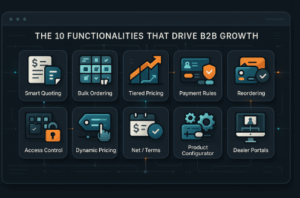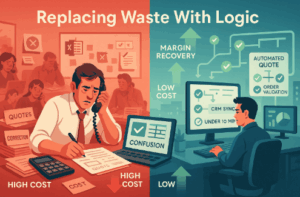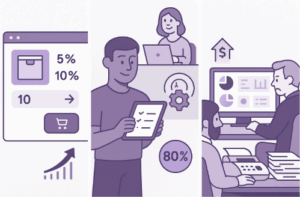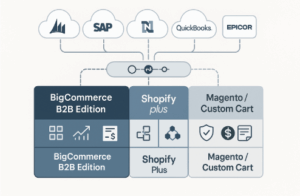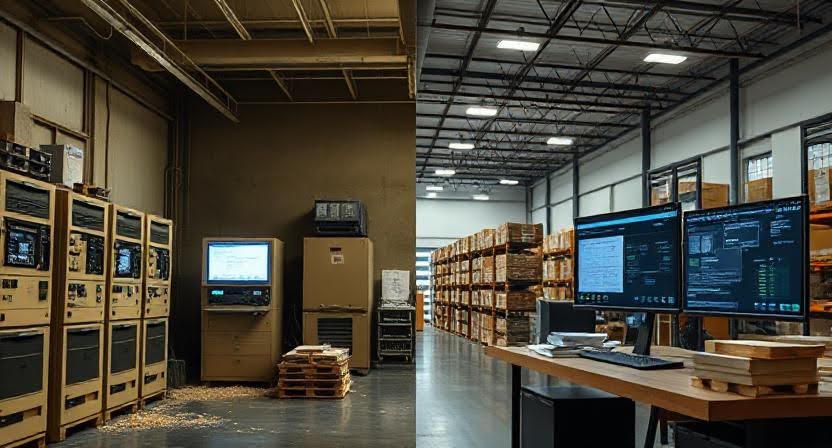You’ve Got $30M in Sales But Still Take Orders on the Phone?
Let’s stop pretending this is normal. You’re a $30M manufacturer. You’ve built a distribution network that spans the country, maybe the continent. You’ve invested in equipment, raw material contracts, shipping partners, trade shows, and a fleet of inside sales reps—but your customers still have to call someone to place a reorder? That’s not customer service. That’s a delay. A friction point. A bottleneck you’ve gotten used to.
We’ve seen this pattern over and over. Business is “doing fine,” but only because sales reps are propping the whole thing up like scaffolding around a cracked building. They’re calling customers to remind them what to reorder. They’re emailing spreadsheets back and forth. They’re updating internal stock in Excel. None of this scales. Worse, it’s invisible waste—until it breaks. And when it breaks, your competitor, who built a self-service portal last year, eats your biggest account without even picking up the phone.
This isn’t about replacing people. It’s about freeing up your people to sell strategically, not chase paperwork or resend quotes.
“We’re Not an eCommerce Company” Is the Most Dangerous Sentence in B2B
We hear this one a lot—usually from a founder who’s spent 20+ years growing the business with grit, referrals, and relationship-driven sales. “We’re not Amazon. We’re not Shopify. Our customers like the way we do things.”
Except they don’t. Not anymore. B2B buyers are aging out. The old-school procurement guy who’s okay calling in a P.O. is retiring. His replacement doesn’t want to talk. He wants to search, customize, and check out on his own time. And if your website doesn’t let him do that, he’s gone.
Being “not an eCommerce company” is like saying, “We don’t use email.” It’s a category error. You are a digital business, whether your systems reflect that or not. Your customers are searching for pricing logic, custom shipping rules, and tiered discounts before they ever ask for a rep. And if they don’t find what they want? Your brand might as well not exist.
The Gap Between B2C Innovation and B2B Paralysis
Here’s the real kicker. The bar for online experience has been set—not by your competitors, but by Amazon, Walmart, and Uline. Every B2C buyer has been conditioned to expect one-click reorders, predictive recommendations, saved carts, volume discounts, and live inventory visibility. That same buyer logs into your B2B site… and gets a glorified catalog PDF with a contact form?
They don’t have time for that.
We see it across every vertical: industrial parts, custom packaging, foodservice supply, even government procurement. B2B leaders are falling behind not because they’re bad at business, but because they’ve misjudged what modern buyers expect. They’ve confused complexity with value.
That’s why platforms like BigCommerce and Shopify Plus are pouring millions into B2B infrastructure. That’s why we’ve built over 750 custom functionalities—because no “theme” or plug-in off the shelf can solve this.
The companies that get it—really get it—aren’t waiting. They’re investing now to get their quoting, ordering, pricing, and fulfillment logic embedded into their websites, not buried in their inboxes.
That’s the difference between surviving and scaling in 2025.
What B2B Buyers Actually Expect Now
Personalized Pricing, Self-Serve Quotes, and Instant Checkout
Your buyer logs in at 7:14 a.m. on a Wednesday. He’s ordered from you before—thousands of dollars’ worth. He knows what he needs. He doesn’t want a sales pitch. He doesn’t want to wait for a rep to “get back to him” with a quote. He just wants to see his price, add the right SKUs to his cart, and either pay or request a quote, on his terms.
If that flow isn’t live on your site, you’re not just frustrating him. You’re giving him a reason to try someone else.
Today’s B2B buyer expects the site to know who they are. They want custom pricing shown as soon as they log in. They want to be able to generate a formal quote with one click—ideally, a downloadable PDF with line items, taxes, shipping, payment terms, the whole thing. And if they’re ready to order, they expect a checkout process that accepts their usual terms: credit card, PO number, ACH, whatever your team previously set up. It needs to just work.
This isn’t a luxury anymore. It’s the baseline. And it’s fully achievable—with the right logic, the right integrations, and the right architecture.
Account-Based Visibility and Locked-In Terms
B2B transactions aren’t like selling T-shirts or phone cases. You’ve got thousands of SKUs, multiple warehouses, different freight rules by region, and often, a client list that includes everything from mom-and-pop shops to billion-dollar chains. Not every customer should see every product, price, or shipping option. That kind of control used to require clunky admin portals or phone-based customer service.
Not anymore.
With the right account-based logic, your site can show exactly what each user needs—and only what they’re allowed to see. Maybe Tier A dealers see MSRP, Tier B gets 20% off, and Tier C has custom-negotiated discounts on specific product families. You can hide certain products from retail buyers altogether. You can show lead times, inventory levels, or freight minimums only to authorized buyers. You can pre-load payment terms and trigger invoice-only orders with zero manual review.
And the best part? All of it happens automatically. No more guesswork. No more calls to confirm pricing. Just smooth, scalable logic that adapts to whoever’s logged in.
That’s how you give each customer a “white glove” experience—without a sales rep lifting a finger.
Reorder Simplicity and Multi-SKU Logic
Reordering shouldn’t be a project. It should feel like checking your inbox.
Let’s say your customer orders the same 47 SKUs every two months. Some items are always in stock. Others rotate based on season or production runs. Right now, you’re asking them to search for every SKU, scroll through product pages, and manually build the cart again?
They’re either calling your sales rep to save time or they’re quietly looking elsewhere.
A modern B2B site remembers those 47 SKUs. It knows what’s been reordered, what’s changed, what’s in stock, and what can ship fastest. It offers reorder templates, past invoice carts, or even pre-populated bundles with suggested adjustments based on recent inventory shifts.
Even better, it nudges the customer: “Ready to reorder these items?” Click. Reviewed. Done.
We’ve implemented this for clients in industrial plumbing, wholesale bakery supply, automotive replacement parts, and more. Every time, the result is the same: fewer calls, faster checkouts, and higher reorder frequency because ease leads to loyalty.
This is what B2B buyers want now: clarity, speed, and control. Not because they’re picky, but because they don’t have time to wrestle with broken systems.
And if you don’t give them that experience, someone else will.
The 10 Most Impactful B2B Functionalities We’ve Built
Let’s get into the real mechanics. Not the marketing-speak. Not the “digital transformation” fluff. We’re talking about functionality, the stuff your business actually needs to sell more, move faster, and cut dead weight from the backend. These aren’t wishlist items. These are proven revenue drivers built for manufacturers, wholesalers, and distributors who’ve outgrown spreadsheets and duct-tape integrations.
We’ve built over 750 of these functionalities. Here are the ten that consistently change the game.
Smart Quoting Engines with PDF & CRM Sync
Quoting is the lifeblood of B2B sales. But most businesses still treat it like it’s 2004. The sales team builds a quote in Excel, emails a PDF, and then manually updates the CRM—if they remember.
Our quoting engines eliminate all of that. Buyers can build a quote right on the site, submit it, and get a polished, branded PDF automatically. That quote syncs to your CRM (HubSpot, Salesforce, Dynamics—take your pick), logs the lead, and notifies your team in real time.
For one packaging supplier, this reduced quote turnaround time from 2 days to 20 minutes. That’s not a productivity win—that’s a conversion engine.
Multi-Asset to Cart Workflows for Bulk Purchasing
B2B buyers rarely shop for one SKU. They’re managing complex orders with 10, 20, 100+ items across categories. And yet, most eCommerce sites force them to add one item at a time, navigating from product to product like they’re shopping for shoes.
That’s a broken flow.
We’ve built multi-asset to cart systems that let users select variants, adjust quantities across multiple lines, and bulk add everything to the cart—all from one view. No page reloads. No back-and-forth. It’s like a B2B command center for ordering.
Result? Larger cart sizes. Faster checkout. Happier procurement officers.
Tiered Pricing Automation by Customer Group or Spend
This one always hits. You’ve got different customer tiers—dealers, distributors, retailers, and institutional buyers. You’ve also got contract pricing, volume discounts, and minimum order thresholds. But managing all that manually? It’s a nightmare.
Our pricing logic automates it all. Assign customer groups, define rules, and let the system serve up the right price every time, based on login, historical spend, or custom rules you define.
It’s not just about showing the right number. It’s about protecting margins, rewarding loyalty, and scaling pricing logic without writing another damn spreadsheet.
Conditional Payment Methods Based on User Permissions
User A can only pay by credit card. User B has net-30 terms. User C requires a PO and invoice workflow. Great—now try coding that into your current checkout without it exploding.
We’ve built conditional payment logic that adapts to the user profile in real time. The moment a buyer logs in, the site knows what payment methods to offer—and which ones to hide. It ties into CRM profiles, order history, even accounting rules.
It’s not sexy. But it’s powerful. And it kills confusion at the most critical step: checkout.
Reorder Portals With One-Click Repurchase
For repeat buyers, friction kills frequency. Nobody wants to rebuild the same cart every time. Reorder functionality solves that.
We build custom reorder portals that show a buyer’s past purchases, let them one-click reorder everything (or adjust SKUs), and automate shipping preferences. Some clients even integrate predictive reorder nudges, based on past usage cadence.
You want stickiness? Start here. This is how you keep a buyer from drifting to your competitor who just launched an Amazon-style quick reorder flow.
Account-Specific Inventory and Visibility Restrictions
B2B is messy. Not every buyer should see every product. Some are distributors. Some are internal reps. Some are clients with negotiated exclusives.
We build systems that let you control what shows up—per user, per login, per region, or per role.
Think of it as digital segmentation at the catalog level. A wholesale HVAC supplier used this to show contractors their regional inventory, hide retail SKUs, and lock in regional freight schedules. The result? Fewer mistakes, happier buyers, and way less admin back-and-forth.
Volume Discounts + Dynamic Pricing by Quantity Ranges
Volume incentives are the heartbeat of high-value B2B orders. But here’s the thing—nobody wants to email you to ask if buying 500 instead of 300 saves them 10%.
We build dynamic pricing that adjusts live on the PDP or in cart, showing tier breaks, discount thresholds, and even bundle logic. Buyers can test pricing scenarios on their own.
And that transparency? It leads to upsells. Every. Single. Time.
Net Terms + Credit Logic at Checkout
“Can I pay with Net-60 terms?” If that question requires a manual review and email chain, you’re losing speed and margin.
We integrate net terms logic directly into checkout, pulling from ERP or accounting platforms. You can pre-approve terms by customer, set credit limits, and even offer “pay later” based on real-time account standing.
Now, your A-list customers get the experience they deserve—without anyone picking up the phone.
Product Configurators for Custom Orders
If you sell anything customizable—sizes, materials, finishes, build-to-order components—you need a product configurator. Period.
We’ve built visual configurators for industrial clients, custom apparel manufacturers, food packaging producers, and more. Users choose their options, get pricing updates live, and submit the order or quote request without miscommunication.
Sales teams stop playing the “what exactly did you want?” game. Orders flow smoothly. Everyone wins.
Dealer, Distributor, and B2G Portal Architectures
Sometimes your customers aren’t end-users. They’re other businesses. They need dashboards, permission-based logins, order tracking for multiple users, and workflows that match how they operate.
We build dealer portals. Government procurement portals. Multi-location distributor networks.
You don’t just sell to them. You become part of how they do business.
Functionalities That Cut Costs—Not Just Improve UX
Let’s do the math no one wants to do.
You’ve got a B2B business doing $25 million in annual revenue. You’ve got 15–20 sales reps managing quotes, purchase orders, reorders, and customer relationships. They’re on the phones all day—not selling, but chasing paperwork. Manually entering orders. Following up on late payments. Correcting SKU mistakes that never should’ve happened in the first place.
Each rep costs you what—$60K to $90K fully loaded? Add in overhead and you’re looking at well over a million dollars a year… to keep a broken machine running.
Now ask yourself: what if half of that could be handled with logic baked into your site?
That’s what custom functionality does. It’s not a “tool.” It’s a full-time employee who never sleeps, never misquotes, and never forgets a discount rule. When we implement smart quoting, dynamic pricing, and reorder automation, our clients don’t downsize—they repurpose. Their best reps start working on strategic accounts instead of being human calculators.
The result isn’t just labor savings. It’s higher throughput with the same headcount. It’s operational leverage.
And it’s how you scale without bloat.
The Hidden Error Rates in Manual Order Entry and Excel-Based Processes
You won’t find this on your P&L, but it’s there—bleeding margin month after month.
Manual entry means errors. Missed digits. Forgotten SKUs. Discounts applied to the wrong account. Freight charges that get eaten because someone mistyped a ZIP code. And when those errors happen, they don’t just cost you money—they cost you credibility.
One packaging supplier we worked with had an error rate close to 4% on manually entered orders. That might sound small. Until you realize that on $1M/month in sales, that’s $40,000 in cleanup, credits, or lost time. Every. Single. Month.
When we implemented real-time order validation with conditional logic and CRM syncing, the error rate dropped to under 0.5%. More importantly, customer complaints stopped. Refunds stopped. Team stress dropped.
That’s the power of letting your systems talk to each other—and cutting Excel out of the loop for good.
From Quote-to-Cash in Under 10 Minutes: A New Speed Standard
Speed wins. In every industry. Every vertical. And in B2B, the difference between a closed deal and a ghosted lead often comes down to how fast you can respond with clarity.
We’ve worked with clients where the typical quote-to-cash cycle was 4–5 days. A buyer submits a quote request, a sales rep builds it manually, emails it, waits for revisions, waits for PO approval, and then manually enters the final order. It’s death by a thousand steps.
Once we built a custom quote generator with PDF output, payment options, and CRM sync, that same cycle dropped to under 10 minutes.
Think about that.
From request to approved quote to order—without human delay.
It’s not just a better experience. It’s a competitive advantage. Because while your competitor is still “getting back to them,” your site has already closed the deal.
Speed is the new trust. And custom functionality makes speed automatic.
Platform Deep-Dive: Where These Functionalities Actually Live
BigCommerce B2B Edition With Middleware Integrations
Let’s get one thing clear—no platform out of the box is going to solve your B2B problems. You’re not plugging in Shopify or BigCommerce and suddenly getting dynamic pricing and multi-SKU reorder workflows. That’s a fantasy.
But some platforms are built for this work. BigCommerce is one of them.
We lean on BigCommerce B2B Edition when our clients have thousands of SKUs, complex pricing rules, and serious ERP or CRM requirements. Why? Because BigCommerce doesn’t try to be flashy, it focuses on flexibility. It’s built to let developers go deep.
We’ve connected BigCommerce to Microsoft Dynamics, NetSuite, SAP, custom freight logic, punchout catalogs—you name it. Want to offer net terms to specific buyers, show different catalogs by customer group, and trigger ERP-based quote workflows in real time? BigCommerce can take that pressure. Especially when we build middleware to connect all the dots.
It’s not cheap. But it works. And it scales.
If you’re serious about industrial eCommerce, this is where a lot of the real work happens.
Shopify Plus for Mid-Tier B2B With Direct-to-Consumer Crossover
Not every B2B business is an enterprise beast. Some of you are in that $3–$10M sweet spot, selling to other businesses but also dabbling in DTC—maybe through Amazon, maybe through your own site. You need agility, not complexity.
That’s where Shopify Plus shines.
Shopify gets a bad rap in B2B circles, but here’s the truth: it’s lightning-fast, ridiculously easy to manage, and its ecosystem of apps and APIs lets us build some wild things. We’ve done tiered pricing, customer-specific catalogs, quote-to-cart flows, and conditional checkout logic—all on Shopify Plus.
If your operation is nimble and your team wants control, Shopify is a no-brainer. It’ll get you 80% of the way there—and with the right development muscle (that’s us), we’ll close the remaining 20% gap with custom functions.
It’s the modern tool for modern operations—especially if you’re trying to outmaneuver slower incumbents.
Magento and Custom Cart Builds for Fully Controlled Backends
Now, if you’re a legacy operation with unique workflows, government clients, or security constraints that make Shopify and BigCommerce a no-go, you’re probably on Magento or some Frankenstein of a custom cart. And that’s okay—if you’re willing to invest.
Magento is a beast. It’s powerful. It’s flexible. But it’s also heavy. You don’t use Magento because you want to “save time.” You use it because you need granular control, deep backend logic, and custom everything.
We’ve rebuilt entire quoting and payment engines inside Magento for clients who had to serve buyers across four continents, in multiple currencies, under strict compliance rules. No SaaS platform could handle it.
And when we go custom—from the cart all the way to the front end—we do it because the business case demands it: maybe it’s a product that needs step-by-step configuration, or a checkout process that has to layer in legal approvals and freight bidding.
This path isn’t for everyone. But when you need it, there’s no substitute.
Integrating With Your ERP or CRM: Microsoft Dynamics, NetSuite, SAP
Here’s the part nobody talks about—but everyone feels.
You could have the slickest B2B site on earth. But if it’s disconnected from your ERP or CRM? It’s just a brochure.
The real value of functionality is when it pulls from your source of truth: your inventory, your customer credit profiles, your live order statuses. We’ve integrated with Microsoft Dynamics NAV and 365, NetSuite, SAP Business One, Epicor, QuickBooks Enterprise—even homegrown systems nobody’s touched since 2008.
And no, it’s not “just plug and play.” It takes custom middleware, data mapping, API bridging, and sometimes reverse engineering a workflow no one has documented.
But once it’s done? Everything just works. Quotes sync. Orders fire. Inventory updates. Payment log. Your eCommerce platform stops being a silo and becomes the growth engine it was supposed to be.
That’s what functionality is for.
You Can’t Outrun Amazon, But You Can Outmaneuver Them
Let’s get real. You’re not going to beat Amazon at logistics. You’re not going to outspend them on tech. And you’re definitely not going to win a race to the bottom on price.
But here’s the good news: you don’t have to.
Amazon is built for mass scale, not specificity. It’s a one-size-fits-most machine. Try asking it to handle a multi-tiered dealer pricing system, or to generate a conditional PDF quote based on freight location and payment history. It can’t. That’s not what it was built for.
You, on the other hand, can build exactly what your buyers need. You can offer quoting workflows that they can’t. You can structure payments around relationships. You can lock in account-based access, tiered logic, and product restrictions by region, industry, or contract terms. You can do the things that make buyers feel like you understand their business, because you actually do.
Amazon sells convenience. You offer a partnership.
That’s the moat.
If you invest in functionality that’s tailored to your B2B operation—your workflows, your buyers, your pricing structure—you stop playing Amazon’s game. You play your own. And that’s a game they’re not built to win.
Start With These 3 Automations to Catch Up Fast
We’ve covered a lot of ground. You might be thinking, “Where the hell do I start?”
Start here.
You don’t need to rebuild your whole system overnight. You just need to fix the friction points that kill momentum. These three automations have the fastest time-to-impact for most B2B businesses—and they don’t require a six-month overhaul.
1. Tiered Pricing Logic for B2B Groups
Set up pricing tiers for your customer segments. When buyers log in, they see their price—not MSRP. Build trust, protect margins, and remove the need for constant manual quoting.
2. Reorder Functionality With Purchase History
Make it dead simple for buyers to reorder what they’ve purchased before. Past orders, saved carts, and one-click repurchase logic means fewer calls, faster checkouts, and better customer retention.
3. Quote-to-Cash Flow With Conditional Payment Logic
Let buyers build and submit quotes directly on your site, then check out based on pre-approved terms. No more chasing down credit approvals or manually building POs. Just fast, controlled conversion.
None of these are flashy. They’re not going to win design awards.
But they will win you sales. And they’ll make your operation a hell of a lot more scalable.
Get a Custom B2B Functionality Audit
You’ve read this far because something hit a nerve. Maybe it was the quoting delays. Maybe the manual reorders. Maybe you’re tired of hearing your team say, “We’ll circle back on that,” when a buyer just wants to place an order.
Whatever the trigger, here’s the truth: the longer you wait to fix this, the more margin you bleed.
We’re not selling fairy dust here. We’re not going to tell you a $500 app will solve years of operational debt. What we are offering is clarity.
A custom functionality audit from Optimum7 means we dig into your current eCommerce setup, front end and back end. We look at what’s costing you time, where your buyers are getting stuck, and which processes are still running like it’s 1998. Then we build a roadmap to fix it—fast.
We’ll show you:
- What functionalities your business actually needs (and which ones are bloat)
- How to layer them into your current platform or move to one that fits better
- Where automation can reduce labor, errors, and friction without ripping out your whole tech stack
This isn’t a one-size-fits-all report. It’s a blueprint built for your team, your workflows, and your buyers.
You’ve already invested in the product. In the team. In the relationships.
Now it’s time to invest in the infrastructure that actually lets all of that scale.
If your B2B site still runs on phone calls, manual quotes, and disconnected spreadsheets, it’s not an eCommerce platform—it’s a liability. Contact us and let’s fix that together. Optimum7 will audit your functionality stack, design the exact automations your business needs, and help you scale without chaos.
Get your audit.





